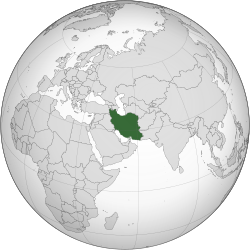Pahlavi dynasty
Pahlavi dynasty سلسله پهلوی | |||||||
|---|---|---|---|---|---|---|---|
| 1925–1979 | |||||||
| Anthem: (1925–1933) سلامتی دولت علیّه ایران Salâmati-ye Dowlat-è Âlliye-ye Irân ("Salute of the Sublime State of Iran") (1933–1979) سرود شاهنشاهی ایران Sorud-è Šâhanšâhi-ye Irân ("Imperial Anthem of Iran") | |||||||
 | |||||||
| Capital | Tehran | ||||||
| Religion | Secular state (1925–1941, 1953–1979) Shia Islam (1941–1953) | ||||||
| Government | Unitary parliamentary constitutional monarchy (de jure 1925–1979 and de facto 1941–1953)
Unitary absolute monarchy (de facto 1925–1941; 1953–1979)
| ||||||
| Shah | |||||||
• 1925–1941 | Reza Shah Pahlavi | ||||||
• 1941–1979 | Mohammad Reza Pahlavi | ||||||
| History | |||||||
• Established | 1925 | ||||||
• Disestablished | 1979 | ||||||
| |||||||
The Pahlavi dynasty (Persian: سلسله پهلوی) is the last Iranian royal dynasty, ruling for almost 54 years between 1925 and 1979. The dynasty was founded by Reza Shah, a Mazanderani[1][2] soldier. The dynasty took on the name of the Pahlavi language spoken in the pre-Islamic Sassanian Empire in order to strengthen his nationalist credentials.[3][4][5][6]
Origins
[change | change source]The dynasty was founded by Reza Shah of Mazanderani descent.[1][2][7] Reza's father was a Mazanderani,[8][9][10][11] commissioned in the 7th Savadkuh Regiment, and served in the Siege of Herat in 1856.[12] His mother was a Georgian Muslim immigrant from Georgia (then part of the Russian Empire).[13][14]
History
[change | change source]The Pahlavi regime established by Reza Shah was a secular, nationalist, militarist and anti-communist regime.[15] Although he himself was of Mazanderani descent, his government carried out an extensive policy of Persianization trying to create a single, united and largely homogeneous nation, similar to Mustafa Kemal Atatürk's policy of Turkification in Turkey after the fall of the Ottoman Empire.[16] After the removal of Reza Shah in 1941, his son, Mohammad Reza Shah, took his place. Finally, the dynasty came to an end with the Iranian revolution.
Sources
[change | change source]- ↑ 1.0 1.1 Aghaie, Kamran Scot (2011). The Martyrs of Karbala: Shi'i Symbols and Rituals in Modern Iran. University of Washington Press. p. 49. ISBN 978-0-295-80078-3.
...Reza Shah [...] He was from a Mazandarani family with a modest military heritage...
- ↑ 2.0 2.1 Amanat, Abbas (2017). Iran: A Modern History. Yale University Press. pp. 473. ISBN 978-0-300-23146-5.
...Reza Shah, himself a Mazandarani...
- ↑ کوروش, نوروز مرادی; نوری, مصطفی (1388). "سندی نویافته از نیای رضاشاه" (PDF). پیام بهارستان. د۲،س ۱،ش۴. Archived from the original (PDF) on 2021-02-26. Retrieved 2022-03-17.
- ↑ معتضد, خسرو (1387). تاج های زنانه (چاپ اول ed.). تهران: نشر البرز. pp. 46, 47, 48, 49, 50, 51 جلد اول. ISBN 9789644425974.
- ↑ نیازمند, رضا (1387). رضاشاه از تولد تا سلطنت (چاپ ششم ed.). تهران: حکایت قلم نوین. pp. 15, 16, 21, 22, 23, 24, 25, 26, 27, 28, 29, 30, 31, 32, 33, 39, 40, 43, 44, 45. ISBN 9645925460.
- ↑ زیباکلام, صادق (1398). رضاشاه (اول ed.). تهران: روزنه،لندن:اچ انداس. pp. 61, 62. ISBN 9781780837628.
- ↑ Koyagi, Mikiya (2021). Iran in Motion: Mobility, Space, and the Trans-Iranian Railway. Stanford University Press. ISBN 978-1-5036-2767-3.
...Reza Shah—a military officer from humble Mazandarani origins who established the Pahlavi Dynasty...
- ↑ Mankoff, Jeffrey (2022). Empires of Eurasia: How Imperial Legacies Shape International Security. Yale University Press. ISBN 978-0-300-26537-8.
...Reza Shah's own father was Mazandarani and his mother from a Georgian immigrant family.
- ↑ معتضد, خسرو (1387). تاج های زنانه (چاپ اول ed.). تهران: نشر البرز. pp. 46–51 جلد اول. ISBN 9789644425974.
- ↑ نیازمند, رضا (1387). رضاشاه از تولد تا سلطنت (چاپ ششم ed.). تهران: حکایت قلم نوین. pp. 15–16, 21–33, 39–40, 43–45. ISBN 9645925460.
- ↑ زیباکلام, صادق (1398). رضاشاه (اول ed.). تهران: روزنه،لندن:اچ انداس. pp. 61–62. ISBN 9781780837628.
- ↑ Ghani, Cyrus (1998). Iran and the Rise of Reza Shah. I.B.Tauris. p. 161. ISBN 978-1-86064-258-6.
- ↑ Afkhami, Gholam Reza (2009). The Life and Times of the Shah. University of California Press. pp. 4. ISBN 9780520253285.
(...) His mother, who was of Georgian origin, died not long after, leaving Reza in her brother's care in Tehran. (...)
- ↑ Gholam Ali Haddad Adel; et al. (2012). The Pahlavi Dynasty: An Entry from Encyclopaedia of the World of Islam. EWI Press. p. 3.
(...) His mother, Nush Afarin, was a Georgian Muslim immigrant (...).
- ↑ Michael P. Zirinsky (1992). Imperial Power and Dictatorship: Britain and the Rise of Reza Shah, 1921-1926. International Journal of Middle East Studies 24. Cambridge University Press. pp. 639–663.
- ↑ Abrahamian, Ervand (1982). Iran Between Two Revolutions. Princeton, New Jersey: Princeton University Press. pp. 123–163.


